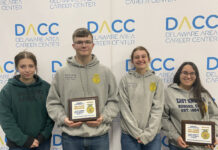WOOSTER, Ohio –Waste is a terrible thing to waste. That’s the mantra guiding an Ohio State University researcher and a bioenergy entrepreneur in the development of a brand-new, renewable source of polyurethane foam that’s expected to create up to 30 jobs in Mansfield, Ohio, in the next two years.
The product (known as a bio-polyol) is made from crude glycerin, a byproduct of biodiesel production that has so little commercial value it’s practically considered waste.
End product
Mixed with other biomass — through a patent-pending process developed by Yebo Li, a biosystems engineer with the university’s Ohio Agricultural Research and Development Center in Wooster — this crude glycerin becomes the foundation for making polyurethane foam, which is used in a variety of products in the construction, automotive, appliance and other industries.
“Polyurethane foam made with our bio-polyol is renewable, biodegradable and its quality is comparable to petroleum-based foam,” said Jeff Schultheis, chief operating officer of Mansfield-based Poly-Green Technologies, LLC, a start-up formed to commercialize Li’s invention.
“And while other bio-polyols now in the market use virgin oils, such as castor bean or soybean, we use a true waste-stream.This makes our product 5-10 percent cheaper than petroleum-based or natural oil-based foams. So we are competing not just on being ‘green,’ but also on overall quality and cost.”
In fact, the bio-polyol developed by OARDC has many other advantages over its competitors that make it an attractive investment: it doesn’t take away crops from food production; it can be used at 100 percent to make products such as insulation boards (other bio-polyols need to be blended with petroleum-based polyols to bring up the quality); and there’s an abundant supply of low-cost crude glycerin in the domestic and international markets.
“For every 10 gallons of biodiesel produced, there’s one gallon of crude glycerin left over,” explained Schultheis, an Ohio State alumnus originally from Zanesville, in southeastern Ohio.
“In 2011, the U.S. biodiesel industry alone will be producing about 70 million gallons of crude glycerin. So there’s a lot of growth potential for this product, and we feel we will be able to enter into the polyurethane market very easily.”
Market
There’s certainly a lot of room to compete in the large polyurethane foam sector, which in the U.S. is worth more than $13 billion, has a demand for 2.8 million tons of the product and heavily depends on petroleum-based sources.
Automobile seats and bumpers, insulation boards, packaging materials, sealants and thermal insulation systems for refrigerators are only a few of the products that could be made from Poly-Green Technologies’ bio-polyol.
To commercialize the product, which is currently in the late-development stage, Poly-Green Technologies recently purchased a 50-gallon reactor that can produce hundreds of thousands of gallons of bio-polyol a year. A much larger, 500-gallon reactor has been ordered to boost production in the near future, and Schultheis said the system can be scaled up even further.
Poly-Green Technologies has also hired a marketing and sales company with ample experience in the polyol industry.
“Between July and September of this year, we plan to enter the market,” Schultheis said. “We feel we could sell 1 million gallons a year for the first two years, and 5 million gallons per year by the fifth year. Within the next two years we will go from three employees currently to between 20-30 employees, so this will be a very good small business for the Mansfield area that’s desperately needing jobs.”
Collaboration
The partnership between OARDC and Poly-Green Technologies began two years ago when Schultheis — then working with Mansfield-based biodiesel company Arlington Energy — was looking for help to address the biorefinery’s glycerin waste-stream.
He contacted Li, whose lab specializes in producing energy, fuels and industrial products from organic waste.
“Dr. Li had already been working on an invention at the time, and during the next few months we began working with him very closely on this process to take the crude glycerin and turn it into abio-polyol to create the polyurethane foam,” Schultheis recalled.
“Since them, Dr. Li and his students have been very motivated to try new things and perfect the formula. They have been very cooperative, accessible and quick to respond to the things we need to commercialize this invention in a very short period of time.”
Funding
In addition to Poly-Green Technologies, Li’s research on bio-polyols has received funding and support from the Ohio Soybean Council.
“Our goal right now is to be able to produce a product with consistent quality, which is always a challenge when you are working with waste sources,” said Li, an assistant professor in the Department of Food, Agricultural and Biological Engineering.
“We have been successful in demonstrating to potential end-users that our foam performs just as well as petroleum-based foam, whether for flexible- or rigid-foam applications.”
The OARDC-Poly-Green Technologies collaboration will not only help Ohio become a leader in renewable polyurethane foam production — it will also support the biodiesel industry, which has been struggling in the past few years but seeks to rebound in 2011.
“In the biodiesel industry, we need to use all of our byproducts to be profitable and sustainable,” Schultheis said. “If Poly-Green Technologies is successful, we will make the biodiesel industry successful. And we will owe it to this great partnership we have with Ohio State.”
Link to the online story at: www.youtube.com/watch?v=igCYJKih3VQ.










